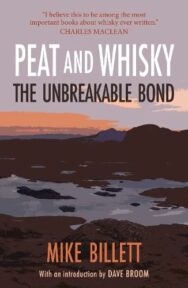‘As a peatland scientist who has worked in peatlands across the northern hemisphere and someone with a passion for whisky, I take the reader on a journey to the places and landscapes that gave birth to a drink, aroma and flavour that is very much part of Scotland and recognised throughout the world.’
Part travelogue, part popular science, and a love letter to Scotland’s most famous artisan product, Peat and Whisky brings together landscapes, geology, ecology, history, people and their whisky, whilst also addressing an important current environmental issue: peatlands and their role in climate change. This Q&A with the author offers an exciting preview of what this book holds in store.
Peat and Whisky
By Mike Billett
Published by Saraband
Tell us what readers can expect when they pick up a copy of Peat and Whisky.
Peat and Whisky is a celebration of the link between Scotch whisky and Scotland’s most important soil. As a peatland scientist who has worked in peatlands across the northern hemisphere and someone with a passion for whisky, I take the reader on a journey to the places and landscapes that gave birth to a drink, aroma and flavour that is very much part of Scotland and recognised throughout the world. Walking into peatland landscapes I reimagine the past as well as look forward to a future in which our peatlands are nurtured and valued as never before.
While the book leans towards the whisky world and is partly a work of popular science, it also highlights the importance of peat to the industry and the communities that depend on it. As such it should attract readers who are not ‘whisky-lovers’, but are interested in the environment, Scottish interest and history. In short, Peat and Whisky is a work of advocacy.
In the introduction of the book, peat is described as ‘a memory bank built up over millennia’. What can the study of peat tell us about the history of Scottish communities?
Peat started forming in Scotland at the end of the last Ice Age and over the next 10,000 years we have a surprisingly complete record of, not only how climate has changed, but also the effects it has had on vegetation and the human population. The forensics of peat through time tell us much about the frequency of fire, the arrival and destruction of forests, cultivation and more recently the fingerprint of industrialisation and pollution.
In researching the book, I came across lots of remarkable stories, including stories of rare finds and artefacts, including a 3,500-year-old buried peat stack on the island of Barra; the oldest cut peat turfs ever discovered. It is a story of abandonment.
Peatland scientists also study at the surface and the scars of the past on the landscape reveal stories of the old ways and the new ways, drainage and restoration, the clearance and displacement of Highland communities.
You make reference to peat being a ‘global soil’, appearing in all seven continents, yet we think of whisky as being the product of just a few select countries. In what other ways is peat used globally, and what can that reveal about our cultural differences and similarities?
While it is true to say Scotland, Ireland and the USA are still the major power houses of production, in recent times there has been an explosion of whisky production across the globe. Some of these new whiskies are outstanding. It is more of an awakening, a desire to make a product that is distinctly different reflecting different tastes, wood types, smoke types and even using peat cut from bogs in such places as Sweden, Minnesota, Tasmania.
In the past peat was used to make an astonishing array of products, although in the modern world its use is declining. While the horticultural and energy industries are still the main players, this varies hugely from country to country. In the first part of the 21st century, the biggest cultural force driving different attitudes to peat use is global warming and the desire of many countries to nurture their peatlands as major stores of carbon, and not exploit them to the detriment of the planet.
What piece of advice would you give to a new whisky drinker on how best to enjoy and appreciate it?
Simple – sample lots of different whiskies and find a style you like – there are so many. Listen and learn. Share and enjoy, join a whisky club or a tasting group, chat and have fun. Visiting distilleries opens your eyes and your mind, not just to the stills and condensers, but to the landscapes and that feeling of place that created the whisky in the first place. Be opened minded. It’s not just about single malts and it’s not just about Scotland. And of course, read.
Tell us a bit about one of your favourite whiskies and what you love about it.
There are many favourites of course, but for me it all started with Caol Ila and that ‘sweet peat’ flavour profile from Islay. Long, slow distillation creates a spirit that seems to work with lots of different wood types. There are several new whiskies including Torabhaig and Ailsa Bay that I also enjoy with similar aroma and flavour. The key for me is getting that lovely balance between the softness of peat smoke and the sweetness of bourbon casks.
Slàinte mhath!
Peat and Whisky by Mike Billett is published by Saraband, priced £12.99.
ALSO IN THIS ISSUE

 Finding Treasure Island
Finding Treasure Island
‘This is the story Jen told me of that dark night. I’ve tried to write it down just as I remember it …

 The 44 Scotland Street Cookbook
The 44 Scotland Street Cookbook
‘On one occasion Bertie and his father, Stuart, embark on a long-awaited fishing trip in the Pentland …













